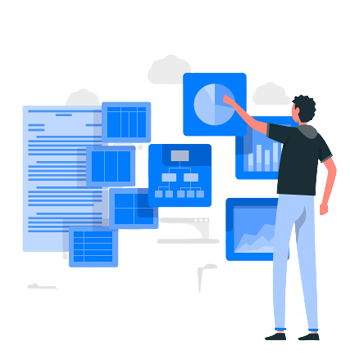What is Web Data Scraping?
Web Scraping is the technique of obtaining structured web data in an automated manner. Web data extraction is another name for it. Pricing monitoring, price intelligence, news monitoring, lead creation, and market research are just a few of the numerous applications of web scraping. Web scraping is used when an organization or a person wants to extract huge volumes of data from the web, this data is further used for gaining insights for decision making.
Web scraping helps save a lot of time as you can extract huge amounts of data which manually wouldn’t be possible for a person or a group to complete.
The data can be extracted based on the customization you desire since web scarping uses intelligent automation scraping which filtres the data points.
What makes Web data scraping the go-to service for companies?
Web scraping is the best way to extract data from the web which will offer you valuable insight and information about your latest competition, with more high-end resources at the disposal of web-scraping companies and the technical expertise their team possesses is what is drawing companies to web scraping. Web scraping is also becoming an indispensable part for analysts since it helps gather the data in the format of their choice to further gain valuable business insights.
The speed at which the data can be extracted is also a plus point because the time a web scraper will take to extract data in a day will be the same as a person collecting data throughout the year.
The basics of web scraping:
Web scraping has two parts a web crawler and a web scraper. The web crawler is the one that leads the process where it takes scraper through the internet to extract the data from different websites. A web scraping tool simply sends a request to the websites and extracts the information from the page. This information is usually visible & accessible on the website to the users. It may also send calls to internal application programming interfaces (APIs) for related data, such as product pricing or contact information, which is kept in a database and supplied to a browser via HTTP queries.
There are a variety of online scraping technologies available, each with its own set of features that may be tailored to fit particular extraction projects. You may require a scraping program that can detect unique HTML site structures or extract, reformat, and save data from APIs.
The Web data scraping process:
- Obtain the URLs of the sites from which you wish to extract data.
- Obtain the URLs of the sites from which you wish to extract data.
- Make a request to these URLs to obtain the page's HTML.
- Locators can be used to find data in HTML.
- Save the information as JSON, CSV, or other structured formats.
It looks simple but it is a layered process to identify the flexibility & scalability of the project based on the parameters set up.
Our team will first understand your requirements and goals, after that once we narrow down & make a list of the sites to scrape. Post that our tech team will analyze the possibility to capture the data from these sites. Whether there are any security checks such as captcha on the website, our system also monitors the overall traffic on these websites so that when we send a request & extract data there is a level of anonymity & the site doesn’t block us for any inhuman activity.
You will also have to share the frequency at which you require the data whether hourly/ daily/ weekly/ monthly & more so that our tech team can have it scheduled within our system. The next step is to share the customized structure for the data columns that we have to follow when we extract the data and the file format in which you want us to share data feeds. After that, we share a sample for review and once we get the approval then we start with the project.
